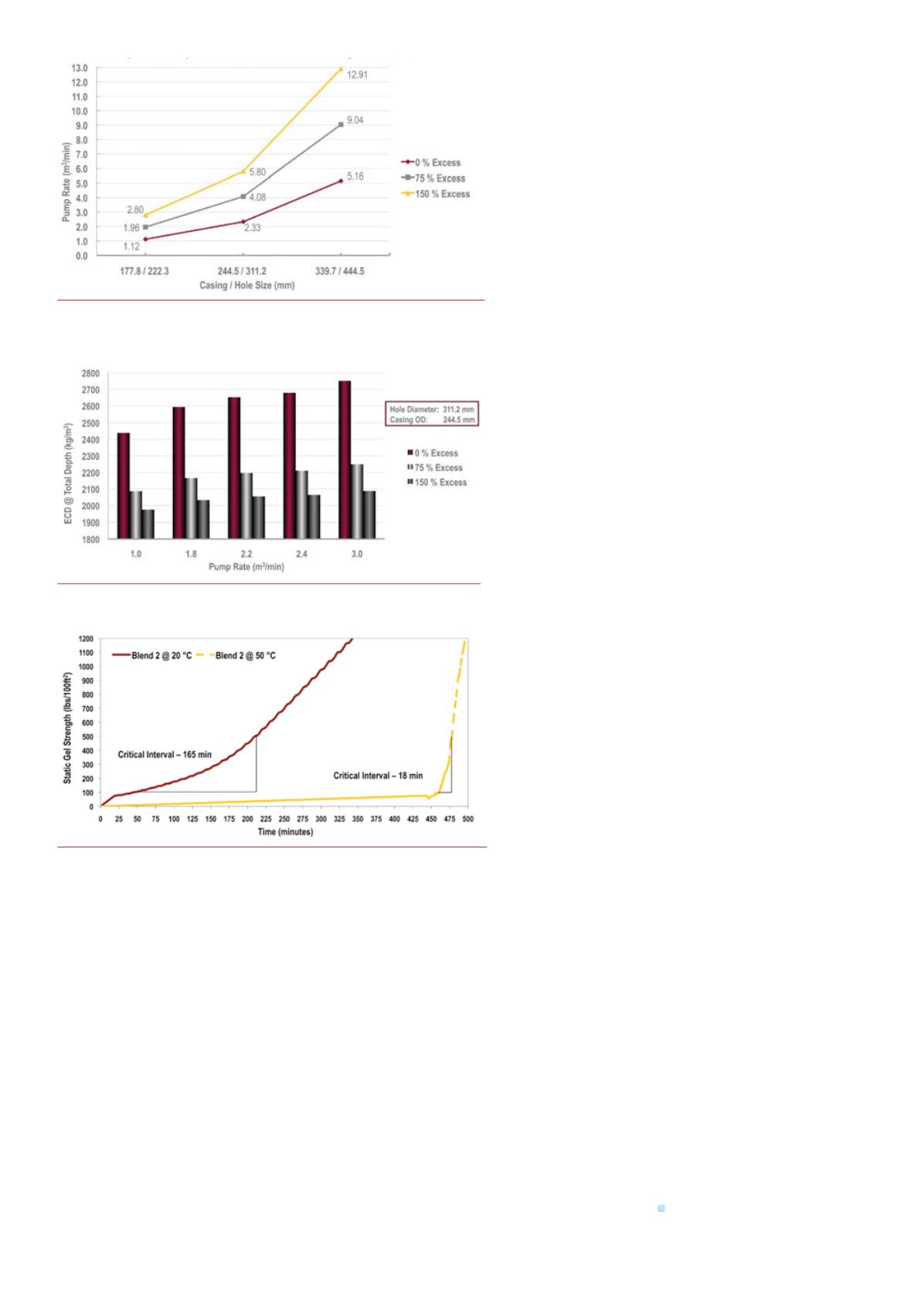
64 |
OilfieldTechnology
February
2014
TheLloydminsterareapresentstwomainchallenges–SCVFsand lost
circulationwhilecementing.Thesechallengesarenormallydealtwith
byusingthixotropiccements, lowfluid loss,zerofreewaterandacritical
intervalof lessthan30min.Sinceasignificantamountofworkhasbeen
completed intheareawithsuccess,theSCVF issuetypicallydoesnotarise.
Inoneparticularproject,described indetail inSPE157922 ‘Elimination
ofSurfaceCasingVentFlowandGasMigration intheLloydminsterArea’,
thefirstcoupleofwellswerecementedusingastandardtemperature
profile.Subsequentwellshadahigherthanexpectede ectiveECD.The
cementblendwasmodifiedtoaccountforthe increasedtemperature
withoutconsiderationforthee ectofthemodificationstotheproperties
describedabove.Thismodifiedblendwasusedonthenextfourwells.The
operationalexecutionwasdeemedsuccessfulastheslurrywasplaced
withexcellentdensitycontrolwithgoodcementreturnstosurface.Eachof
thefourwellsexhibitedaSCVF. Inordertosatisfytheregulatoryboard,a
cementbondlog(CBL)wasrequired.Thebond logsrevealedareas inthe
wellthathadpoorbond.
An investigationwasconducted inorder to fullyunderstand
the issue. Itstartedwithunderstanding thesourceof thegas that
wasgetting tosurface.Asampleof thegaswas testedand revealed
that thesourceof thegaswas fromadepthofapproximately
265-325m (869-1066 ), identifyinganeed to furtherexplore that
specific formationdepth.
The increasedwell temperaturewas reported tohave
increased thecirculating temperature from20˚C (68˚F) to
approximately45˚C (113˚F).Upon further investigation, the
increase in temperaturewasdue to thebottomof thewellbore
beingwarm,butnota ecting theupholeareas.Thismeant that
whenstatic, thecementslurryupholewasnotsubjected to the
increase in temperatureaspreviouslyexpected.Thesignificanceof
this finding is that thegradientwithin thewellbore,despitebeing
relativelyshallow indepth, isveryhigh.AstudybySabins,Tinsley
andSuttonshowed thatawide temperaturegradientcouldhavea
negative impacton thesettingofcementat the topof thecolumn.
Thecementpropertycommonlyusedtoexplainsettingunder
staticconditions isthecritical interval.Thecritical interval is
determinedbyastaticgelstrengthtest,and isdefinedbythetime
between48Pa (100lbs/100
2
)and240Pa (500lbs/100
2
).When
thegelstrength is lessthan48Pa (100 lbs/100
2
), there isenough
hydrostaticpressure fromthecolumnofcementtoholdbackthe
downholepressure.Thetransition fromthispointtowhen ithas
enoughgelstrengthtoresistthepressure (240Paor500lbs/100
2
)
isconsideredthecritical interval.Sabins,TinsleyandSutton’sstudy
showedthatduringthistransition, fluidhasthebestchanceof
migratingthroughthecement.
Thecritical intervalsof themodifiedblendwere foundtobe
165min.at20˚C (68˚F)and18minutesat50˚C (122˚F)asshown in
Figure3.
Thedesign temperaturewas50˚C (122˚F)and the
temperatureof theshallow formation,whichwas thesourceof the
gas,was20˚C (68˚F). Inorder toaid in thepreventionofSCVF,a
critical intervalof less than30min. is targeted.Themodifiedblend
was redesigned toachieveacritical interval less than30min.at
20˚C (68˚F).
Alongwiththis improvementtothemodifiedblend, thepump
rateswerealso increased inanattemptto improvedisplacement
e iciency. Inthis instance, the increase inpumpratescreatednew
challenges,as lostcirculationwasencountered.The lostcirculation
maybeaconsequenceofan increasedpumprate leadingtoan
increase intheECDthatthe formation isexperiencing.
Thepump rateswere reduced tomeeta targetECDand the
redesignedcementblendwasutilised resulting in improved
CBLsandeliminationof theSCVF.With the reducedpumping rates,all
thecementingoperationsattainedcement returns tosurface.
Summary
Bestpracticesareknownacross theoilandgas industrybyboth
servicecompaniesandE&Pcompanies,andsignificantworkand
investigationhasbeencarriedout indeveloping, improvingand
implementingdi erentbestpractices.Theareaand typeof
applicationwhereeachbestpracticeprovesmoste ectiveneeds to
bedeterminedso thatadditionalornewchallengesarenot
encounteredasa resultof implementation.Theexperienceand tools
available to theservicecompaniesandE&Pcompaniescan reduce the
learningcurve,buteachchallenge that isencounteredmustbe fully
understoodwithaproper investigation inorder to fullyeliminate the
issue.Onlyonce the issue iscompletelyunderstoodwillasolution,
whetherabestpracticeoracustomisedsolution,have thegreatest
chanceof solving thechallenge.
Figure3.
Pumpratesrequiredtoachieveannularvelocityof80m/min.
(262.5 /min.)forvariouswellboreconfiguration.
Figure4.
ECDversuspumprate.
Figure5.
Critical intervalat20˚C(68˚F)and50˚C(122˚F).


